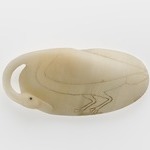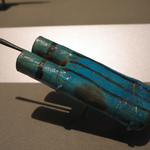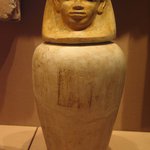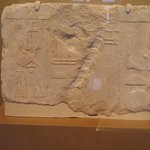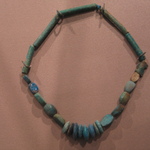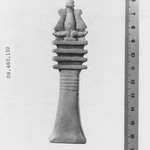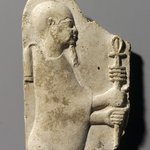

Furniture Attachments in Form of Tyt-Amulet and Djed-Pillars, ca. 1539–1292 B.C.E. Wood (acacia?), a: 8 × 1 7/8 × 9/16 in. (20.3 × 4.7 × 1.5 cm). Brooklyn Museum, Charles Edwin Wilbour Fund, 37.253Ea-c. Creative Commons-BY (Photo: Brooklyn Museum, 37.253Ea-c_view2_SL1.jpg)

Furniture Attachments in Form of Tyt-Amulet and Djed-Pillars, ca. 1539–1292 B.C.E. Wood (acacia?), a: 8 × 1 7/8 × 9/16 in. (20.3 × 4.7 × 1.5 cm). Brooklyn Museum, Charles Edwin Wilbour Fund, 37.253Ea-c. Creative Commons-BY (Photo: Brooklyn Museum, 37.253Ea-c_SL4.jpg)
Furniture Attachments in Form of Tyt-Amulet and Djed-Pillars
Egyptian, Classical, Ancient Near Eastern Art
On View: Egyptian Orientation Gallery, 3rd Floor
Wood, Bone, and Ivory in the New Kingdom
Egyptian artists were resourceful in overcoming the problems of working with difficult materials to make the objects seen here.
Egyptian trees, such as acacia, sycamore, and tamarisk, are too small to produce large planks. Carpenters working with native woods thus had to develop complicated joinery techniques to build large objects like coffins and furniture. For expensive luxury items they used timbers such as ebony, cedar, and juniper, imported from Nubia and Punt to the south and Syria and Lebanon to the northeast. Ancient craftsmen used tools that would be familiar to modern carpenters, including adzes, chisels, reamers, and saws. Many ancient Egyptian wooden objects left in tombs as funerary offerings have survived remarkably well. Undisturbed tombs maintain extremely stable climatic conditions, slowing the effects of repeated expansion and contraction that are so damaging to wood. Egypt’s relatively dry climate also discourages the growth of mold, insects, and microorganisms that feed on wood.
Ancient Egyptian ivory used for carving came from the tusks of elephants and hippopotami. Elephants had probably disappeared from Egypt by the end of the Predynastic Period (circa 3100 B.C.E.), so their ivory had to be imported from Nubia. Hippopotami remained common in the lower Nile Valley until the seventeenth century C.E. Some antiquities mistakenly said to be made of ivory are actually made of the bones or antlers of cattle, sheep, goats, and antelopes. Egyptians used the often ideally shaped leg bones of these animals to create the handles of tools or weapons.
Egyptian artists were resourceful in overcoming the problems of working with difficult materials to make the objects seen here.
Egyptian trees, such as acacia, sycamore, and tamarisk, are too small to produce large planks. Carpenters working with native woods thus had to develop complicated joinery techniques to build large objects like coffins and furniture. For expensive luxury items they used timbers such as ebony, cedar, and juniper, imported from Nubia and Punt to the south and Syria and Lebanon to the northeast. Ancient craftsmen used tools that would be familiar to modern carpenters, including adzes, chisels, reamers, and saws. Many ancient Egyptian wooden objects left in tombs as funerary offerings have survived remarkably well. Undisturbed tombs maintain extremely stable climatic conditions, slowing the effects of repeated expansion and contraction that are so damaging to wood. Egypt’s relatively dry climate also discourages the growth of mold, insects, and microorganisms that feed on wood.
Ancient Egyptian ivory used for carving came from the tusks of elephants and hippopotami. Elephants had probably disappeared from Egypt by the end of the Predynastic Period (circa 3100 B.C.E.), so their ivory had to be imported from Nubia. Hippopotami remained common in the lower Nile Valley until the seventeenth century C.E. Some antiquities mistakenly said to be made of ivory are actually made of the bones or antlers of cattle, sheep, goats, and antelopes. Egyptians used the often ideally shaped leg bones of these animals to create the handles of tools or weapons.
MEDIUM
Wood (acacia?)
DATES
ca. 1539–1292 B.C.E.
DYNASTY
Dynasty 18
PERIOD
New Kingdom
DIMENSIONS
a: 8 × 1 7/8 × 9/16 in. (20.3 × 4.7 × 1.5 cm)
b: 8 1/16 × 2 3/16 × 5/8 in. (20.5 × 5.5 × 1.6 cm)
c: 8 1/16 × 2 1/16 × 11/16 in. (20.5 × 5.3 × 1.8 cm) (show scale)



COLLECTIONS
Egyptian, Classical, Ancient Near Eastern Art
ACCESSION NUMBER
37.253Ea-c
CREDIT LINE
Charles Edwin Wilbour Fund
CATALOGUE DESCRIPTION
One wooden ty.t or "Isis girdle" (a) and two (b-c) wooden Djed pillars. That these pieces were once part of a piece of furniture is indicated by the presence on each piece, at both the top and bottom, of a tang pierced with a hole. The wood is light, possibly acacia.
Condition:
a)Upper and lower tangs broken. Partially inlaid with bitumen.
b) Lower crossbar chipped in left rear. Adhesive remains around both tangs. Superficial scratching.
c) Upper crossbar damaged. Chipped in front. Some adhesive remains on tangs. Superficial scratching, Some bitumen remains.
EXHIBITIONS
MUSEUM LOCATION
This item is on view in Egyptian Orientation Gallery, 3rd Floor
CAPTION
Furniture Attachments in Form of Tyt-Amulet and Djed-Pillars, ca. 1539–1292 B.C.E. Wood (acacia?), a: 8 × 1 7/8 × 9/16 in. (20.3 × 4.7 × 1.5 cm). Brooklyn Museum, Charles Edwin Wilbour Fund, 37.253Ea-c. Creative Commons-BY (Photo: Brooklyn Museum, 37.253Ea-c_view2_SL1.jpg)
IMAGE
overall, 37.253Ea-c_view2_SL1.jpg. Brooklyn Museum photograph
"CUR" at the beginning of an image file name means that the image was created by a curatorial staff member. These study images may be digital point-and-shoot photographs, when we don\'t yet have high-quality studio photography, or they may be scans of older negatives, slides, or photographic prints, providing historical documentation of the object.
RIGHTS STATEMENT
Creative Commons-BY
You may download and use Brooklyn Museum images of this three-dimensional work in accordance with a Creative Commons license. Fair use, as understood under the United States Copyright Act, may also apply.
Please include caption information from this page and credit the Brooklyn Museum. If you need a high resolution file, please fill out our online application form (charges apply).
For further information about copyright, we recommend resources at the United States Library of Congress, Cornell University, Copyright and Cultural Institutions: Guidelines for U.S. Libraries, Archives, and Museums, and Copyright Watch.
For more information about the Museum's rights project, including how rights types are assigned, please see our blog posts on copyright.
If you have any information regarding this work and rights to it, please contact copyright@brooklynmuseum.org.
RECORD COMPLETENESS
Not every record you will find here is complete. More information is available for some works than for others, and some entries have been updated more recently. Records are frequently reviewed and revised, and we welcome any additional information you might have.



